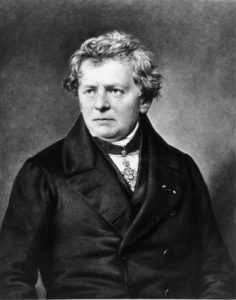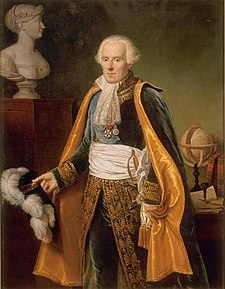A material that allows electrically charged particles to flow through it is a conductor. This can be metals that allow electrons to move about freely or a tube carrying a solution of positively charged ions such as a neuron. Applying a voltage to a conductor causes current to flow through it. Also, flowing current through a conductor creates a voltage across it. For a conductor, voltage and current are intimately connected and the application of either produces the other.
Ohm’s Law
Resistance is a key property of conductors, it establishes a proportional relationship between voltage and current with resistance being the constant of proportionality. This intimate connection is captured by Ohm’s Law, V = I * R.
V = I * R; Voltage = Current x Resistance
A conductive device that exhibits the property of resistance is called a resistor, and Ohm’s Law states that the voltage across a resistor is proportional to the current flowing through it, and the constant of proportionality is the resistance of the resistor. The more resistance a conductor has, the less current flows for a given voltage, or conversely the more voltage is produced for a given current. Ohm’s Law is probably the equation most used by electrical engineers.
V ∝ I; Voltage is proportional to current,
Resistance is the constant of proportionality

Capacitance and Inductance
Conductors have additional properties besides resistance that affect voltage and current. These are CAPACITANCE and INDUCTANCE, and these properties cause a time delay between changes in voltage and current. In the case of capacitance, current leads voltage (i.e. current changes fast and voltage changes more slowly). And in the case of inductance voltage leads current (i.e. voltage changes fast and current changes more slowly). Conductors can and do have varying degrees of resistance, capacitance, and inductance all at once.
Properties of Conductors that Affect the Relationship Between Voltage and Current
Resistance
– Units: Ohms (Ω); Symbol: R, rThe resistance of a conductor to the flow of electric charge
Capacitance
– Units: Farads (F); Symbol: C, cThe ability to store electric charge
Amount of opposition to a change in voltage
Inductance
– Units: Farads (F); Symbol: L, lAmount of opposition to a change in current
Think of inductance as giving momentum to current reducing the rate at which current can change depending on the amount of inductance.
Laplace Transformation
The relationship between voltage and current as functions of time for a conductor with capacitance or inductance is a differential equation. Differential equations are difficult to work with and their complexity quickly gets out of hand. So instead, electrical engineers use a mathematical tranformation to make things simpler: the LAPLACE TRANSFORMATION.

The Laplace transformation transforms functions of time into functions of the Laplace variable (s), which is a complex number: a scaling factor (σ) plus the imaginary number (j) times the natural frequency (ω).
In electrical engineering, we use j for the imaginary number instead of i, because i means current, period. We had already defined current to be i when you came along with your imaginary number, so you get j. The imaginary number, j, is the square root of -1.
Imaginary Number: ![]()
Natural Frequency: ![]() ; ω in radians, f in Hertz
; ω in radians, f in Hertz
Laplace Variable: ![]()
I am not going to show you how to perform Laplace transformations, but as we go along I will state the basic Laplace transformations EEs should remember.
Impedance
Laplace transformation changes resistance, capacitance, and inductance into one complex number quantity called IMPEDANCE. Impedance (Z) has a real portion, which is the resistance, and an imaginary portion, which is called the REACTANCE (X) and represents the combination of capacitance and inductance. The imaginary portion is the part of the impedance that varies with time and frequency, and the real portion is the time-invariant part.
Z(s) = R + jX(s); Impedance = Resistance + Reactance * Imaginary Number
Applying Laplace transform to functions of voltage and current allows the formation of the generalized form of Ohm’s Law that applies to capacitance and inductance as well as resistance. The quantities are functions of the Laplace Variable, s.
V(s) = Z(s) * I(s); Voltage = Impedance * Current
See how much simpler that is than a differential equation? That is why we use Laplace. EEs often refer to functions that have been Laplace transformed as being in the FREQUENCY DOMAIN as opposed to being in the time domain, since the natural frequency is part of the Laplace variable.
When voltage and current vary together in time and not differently in time, the imaginary portion of the impedance Z is zero and the impedance is just the resistance of the conductor. To say that another way, the real portion of the impedance is the resistance, and the imaginary portion of impedance is the combination of inductance and capacitance. This combination of inductance and capacitance is called reactance.
More on the Laplace Variable ‘s’
s = σ + j*ω. The sigma (σ) and omega (ω) portions of the Laplace variable have meaning in the physical world. Sigma represents transient cases that do not persist over time. Omega represents the persistent cases called steady-state.
σ relates toTransients
ω relates to Steady-State
This infomation can be used to simplify reverse Laplace transformation where we move from frequency domain to time domain. Often one only wants to determine the steady-state case. For the steady-state, σ = 0 and s = jω. So, to determine steady-state in the time domain, just substitute jω for s in your equations. In Electrical Engineering, this is called determining the FREQUENCY RESPONSE as opposed to determining the TRANSIENT RESPONSE.
Transients are represented mathematically as transient sinusoids and exponential functions.
Here is an excellent deeper dive into LaPlace Tranformations by Math and Science on Youtube.
Next: Signals
